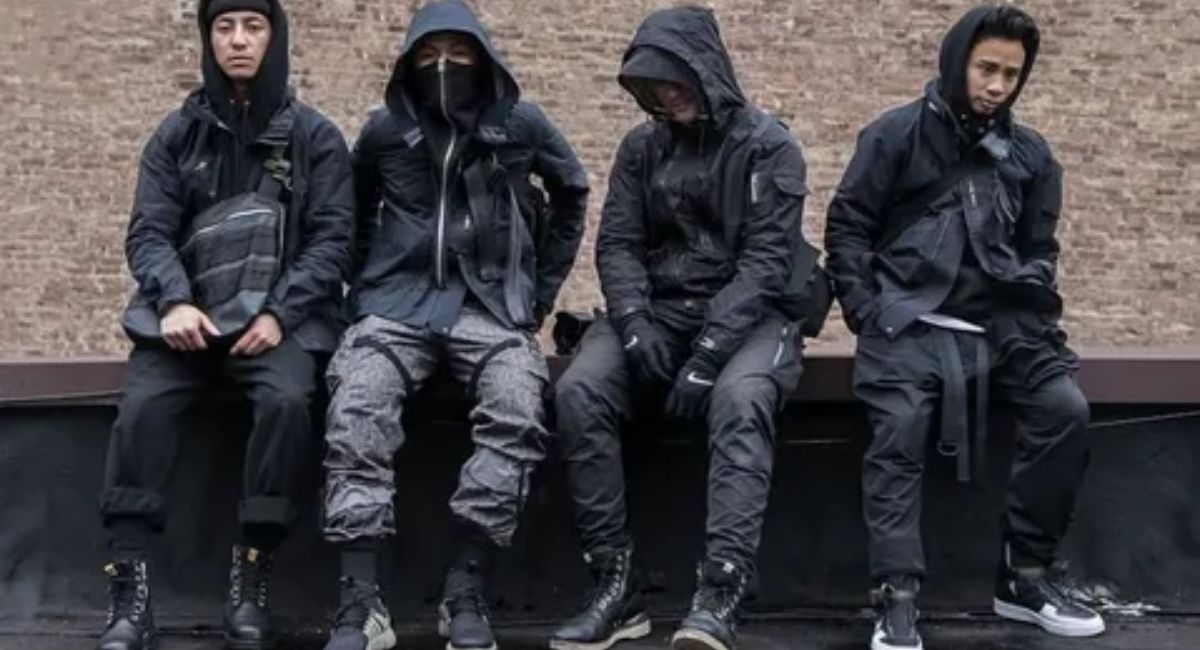In the world of style, few trends spark as much intrigue as Dystopian Fashion. This edgy, forward-looking aesthetic blends futuristic fashion, post-apocalyptic clothing, and cyberpunk fashion into a bold statement of rebellion and individuality. It’s more than just clothing—it’s a reflection of society’s anxieties, resilience, and the blurred line between chaos and control
. Rooted in sci-fi influences, dystopian style captures the essence of survival and adaptability in a modern, uncertain world. From darkwear aesthetic designs to rugged utility wear, this trend speaks to those who want to stand out while expressing strength, defiance, and a readiness for whatever the future brings.
What Is Dystopian Fashion?
So, what does dystopia mean in fashion? Simply put, it’s a fashion that reflects society—especially its darker, more uncertain sides. Dystopian fashion takes inspiration from survival, rebellion, and the desire for control in an unpredictable world. It’s a blend of futuristic and survival clothing, merging practicality with bold aesthetics. The look is often defined by utility wear, distressed textures, and rugged layers.
This isn’t just another edgy fashion trend. The psychological meaning behind dystopian fashion runs deep. It’s about wearing one’s awareness of global tension and change—be it through warcore trend jackets or darkwear aesthetic pieces. For many, dressing this way feels empowering, like an armor against chaos. Resilience and individuality through fashion are at the heart of this style, transforming fear into strength and survival into art.
The Meaning of Dystopia in Modern Style
The dystopian fashion mindset mirrors how people feel in today’s world—cautious but creative. It’s a form of fashion as social expression, showing how individuals use wearable survival gear and symbolic accessories to navigate modern uncertainty. Dystopian accessories (masks, goggles, harnesses), once reserved for fantasy or industrial workwear, are now common on runways and urban streets alike, blending fashion with function.
Origins of Dystopian Fashion: From Sci-Fi to Streetwear
The roots of dystopian fashion in streetwear stretch back decades. Early sci-fi fashion in literature and film planted the seeds for what would become a global phenomenon. George Orwell’s 1984, Aldous Huxley’s Brave New World, and later movies like Blade Runner and The Matrix gave visual form to the idea of rebellion through clothing. Their characters wore survival-inspired fashion, reflecting both societal decay and human resilience.
When analyzing how dystopian movies influence clothing, it’s clear that storytelling and style evolved together. Films like Mad Max introduced post-apocalyptic clothing layered with purpose and personality, while The Hunger Games popularized the idea of functional rebellion wear. Over time, futuristic streetwear borrowed from these aesthetics, bringing dystopia from fiction to sidewalks.
| Influential Source | Contribution to Dystopian Fashion |
| Mad Max | Popularized rugged, survival-inspired outfits |
| Blade Runner | Defined the cyberpunk fashion visual |
| The Matrix | Influenced darkwear aesthetic with minimal, black tones |
| The Hunger Games | Introduced rebellion as wearable symbolism |
The Shift from Fiction to Everyday Wear
The transformation from movie costume to functional fashion design happened gradually. In cities like Los Angeles and New York, high-end dystopian fashion brands began reimagining movie-inspired looks for everyday use. Designers took cues from techwear outfits, blending futuristic fabrics with streetwear practicality. What started as a costume for actors became a daily choice for anyone seeking dystopian fashion inspiration.
Key Elements and Features of Dystopian Fashion
Every dystopian aesthetic outfit shares a few recognizable traits. Dark tones dominate—black, gray, and olive set the mood. Materials are raw and lived-in, from distressed leather to heavy denim. Outfits often feature layers upon layers, mixing textures like wool, canvas, and synthetic blends. These elements create the feeling of apocalyptic style—a world rebuilt from the ruins of the old.
The Core Components
One of the defining traits is utility wear. Straps, pockets, and zippers aren’t just decoration—they serve purpose. Tactical clothing inspired by military gear provides durability and readiness. Meanwhile, asymmetry in cuts and silhouettes adds a futuristic edge. Masks, goggles, and metallic accessories inject a touch of avant-garde fashion, balancing rebellion with innovation.
Popular Dystopian Fashion Styles
Several key subgenres have emerged within dystopian fashion. Cyberpunk fashion merges sleek, metallic materials with neon accents. It’s a world where technology meets grit, where futuristic fashion becomes rebellion. Darkwear aesthetic strips it back to simplicity—monochrome looks that are minimalist yet commanding. Warcore trend outfits mix soldier-like details with streetwear comfort, while post-apocalyptic clothing captures the raw, hand-stitched energy of survival.
The diversity within these styles allows people to express who they are in their own modern dystopia. Some lean toward the mechanical futurism of grunge tech style, while others favor the rugged functionality of survival-inspired fashion. Together, they represent a spectrum of self-expression born from uncertainty.
Dystopian Fashion in High-End Streetwear

Luxury fashion houses have embraced the chaos too. From Rick Owens to Balenciaga, high-end dystopian fashion brands are now redefining futuristic streetwear with sculpted silhouettes and industrial materials. What used to be niche is now luxury. These labels tap into a shared emotion—wearing one’s defiance with pride.
American designers have played a major role in blending streetwear with futuristic influence. Dystopian fashion in streetwear thrives on limited drops, muted palettes, and an emphasis on individuality. This hybrid style—part armor, part art—turns fear into fashion, giving wearers control in an unpredictable world.
How Runway and Street Culture Collide
Runway shows in New York, Los Angeles, and Paris have blurred the line between couture and combat. Influencers and musicians amplify the aesthetic online, transforming rebellion fashion into global conversation. Artists like Kanye West and Billie Eilish embody the dystopian fashion mindset, using clothing to challenge norms and symbolize strength in vulnerability.
Why Dystopian Fashion Appeals to Today’s Generation
People don’t wear dystopian clothes just for the look—they wear them for what they represent. In an age shaped by social tension, digital overload, and climate anxiety, dystopian style feels authentic. It speaks to a collective yearning for resilience and freedom. This is fashion as social expression at its rawest form—unfiltered, protective, and deeply personal.
Fashion as a Reflection of Modern Anxiety
Younger generations, especially Gen Z, see clothing as an emotional shield. They’re drawn to functional fashion design that feels both stylish and strong. Why dystopian fashion is trending becomes obvious—it reflects how people adapt to modern stress while asserting identity. Through dystopian aesthetic outfits, they declare readiness, creativity, and independence in a chaotic era.
Top Designers and Brands Defining Dystopian Style
Many designers have pioneered this movement. Rick Owens introduced the world to avant-garde futuristic fashion with gothic undertones. Acronym merged techwear outfits and innovation, making urban gear desirable. Balenciaga reimagined post-apocalyptic clothing as couture, while Yohji Yamamoto infused Japanese artistry into darkwear aesthetic minimalism.
These designers understand that fashion that reflects society needs depth, not decoration. Their work merges art and survival, showing how clothing can express defiance, not despair. As consumers demand meaning, the future of dystopian fashion inspiration looks bright—even if its colors are dark.
How to Style Dystopian Fashion in Everyday Life
If you’re wondering how to style dystopian outfits, the answer is simple: start small. Add utility wear pieces like a harness or asymmetrical jacket. Mix textures—smooth leather with rugged denim—to create contrast. Stick to darker hues and play with structure rather than color.
Layering is key in everyday dystopian fashion ideas. Pair combat boots with long coats, then add accessories like belts or fingerless gloves. The goal is to look purposeful, not theatrical. Think futuristic and survival clothing, but wearable for coffee runs, not just cosplay conventions.
The Future of Dystopian Fashion
The next evolution of dystopian fashion is already underway. Technology and sustainability are merging to reshape the narrative. As AI and recycled fabrics redefine design, futuristic streetwear will move toward smarter, eco-conscious pieces. Designers are now exploring 3D-printed materials and digital wearables—creating fashion that exists in both physical and virtual spaces.
Dystopia Meets Innovation
Soon, dystopian aesthetic outfits will transcend fabric. In the metaverse, techwear outfits and avant-garde fashion pieces can express identity without waste. This digital revolution mirrors the same mindset that birthed dystopia: adaptability. The future isn’t about avoiding chaos—it’s about styling through it.
FAQs About Dystopian Fashion
What does dystopia mean in fashion?
It’s about expressing rebellion, strength, and adaptability through clothing that feels raw and real.
Is dystopian fashion the same as cyberpunk fashion?
Not exactly. Cyberpunk fashion is more futuristic and tech-driven, while dystopian style leans into survival and rebellion.
How to style dystopian outfits casually?
Combine utility wear, dark tones, and layered textures for a look that’s functional yet stylish.
Why is dystopian fashion trending now?
It resonates because people want resilience and individuality through fashion, reflecting today’s uncertain world.
Conclusion: Embracing the Chaos with Style
In the end, dystopian fashion isn’t just about looks—it’s about mindset. It’s the art of turning instability into inspiration, merging futuristic fashion with emotion. Through rebellion fashion and functional fashion design, people are crafting their identities in a chaotic world. This movement reminds us that even in collapse, creativity thrives. To wear dystopia is to wear strength—proof that style can rise from ruins and redefine what it means to be human.

Welcome to Info CelebPro!
I’m Munzza Taimoor, an AI-powered SEO and content writer with three years of experience. I help websites rank higher, attract more traffic, and look stunning online. My goal is to make SEO and web design simple, effective, and accessible for everyone.
Let’s achieve more together and take your digital presence to the next level!

